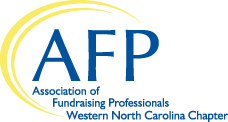Mark Goldstein, CFRE, GPC, is the President and CEO of Communication Mark, offering a full range of grant writing services for the past 25 years. Mark has raised more than $100 million in grants for organizations of all types and sizes, particularly for health, human service, community development and technology needs. He is the past President of the Grant Professionals Association North Carolina Chapter and an active member of AFPWNC, recognized as the region’s Outstanding Fund Raising Executive in 2019. Mark has provided training sessions through WNC Nonprofit Pathways, the Duke University Continuing Studies Nonprofit Management program, and Alliance for Better Nonprofits.
For April’s blog article, we’re focusing on grants, and Mark Goldstein is certainly no fool when it comes to grant writing! We asked him to answer some questions to help you be more successful in securing funding from your grant proposals.
1. How do you assess whether a grant is worth applying for?
Several factors come into play. When you spot an enticing prospect, a key question to consider is the grantmaker’s geographic focus, particularly with private foundations. Will this funder make awards to where your organization provides services, how often has it made awards in your county, and what size grants have been awarded to comparable organizations near you? The answers can be found for free on funder websites, in grantmaker 990 forms posted on Candid or in for-pay foundation databases. Next, read grantmaker guidelines to see whether you meet other requirements. Review their focus areas and carefully consider whether they fit what you do and if they share a similar philosophy.
2. What’s the best way to align a proposal with a funder’s priorities?
If you can’t realistically make a case for alignment, you are unlikely to be funded, and your energy will be better spent elsewhere. If you are aligned well enough, you must demonstrate that a grant will enable your organization and the funder to fulfill their respective missions. You can maximize alignment by only requesting funds for parts of the project that address grantmaker priorities. For instance, if your focus is on providing housing repair assistance to anyone in need, and the funder’s focus is on providing any type of assistance to older adults in need, you can ask the foundation to support repairs to seniors’ homes. As you write, be sure to emphasize points that demonstrate alignment with the funder—don’t assume the alignment can go unstated.
3. How do you make a proposal stand out from others?
Definitely submit it on bright pink paper (ha! just kidding). I don’t recommend anything odd that might make the application less legible or try reviewers’ patience. Often, just following guidelines, using clear language, and demonstrating a great need for a vital service will move your application toward the top of the stack. To make it stand out even more, dig deep for data and timely news items that indicate a crisis you can help avert; include an appropriate short story of how a client’s life clearly improved; forecast specific, realistic, but ambitious measurable and time-sensitive outcomes; and share accomplishments that show you have improved many people’s lives.
4. What are some common mistakes in grant writing and how can they be avoided?
As a reviewer, I see many mistakes that can easily be addressed. Common ones include not following instructions carefully; failing to explain the problem affecting your organization’s service area (e.g., only citing state or US stats); providing answers that don’t entirely address application questions; and spending too little time organizing applications (for example, scattering community needs throughout an application instead of relegating them to the ‘Need Statement’ section). All of these errors can be avoided by building in time to reread your draft and correct problems. It also helps to have someone unfamiliar with the project review the application and provide feedback.
5. How do you incorporate data and storytelling effectively?
Craft a clear, concise narrative you believe in that logically explains why your project is crucial. Gather data about the needs you believe must be addressed, and the strategies or methods you trust will make an impact. Incorporate data and anecdotes wherever your story needs validation or documentation. For instance, if you address breast cancer, data might illustrate it is a big problem locally (using data on mortality, cases reported, county health needs assessments, etc.). If you propose to combat lung cancer through screenings, you can cite data showing that early treatment results in a better prognosis. You can quote local people who have had lung cancer and say early treatment did, or would have, made their lives better, proving your point and raising the emotional stakes of your story.
6. What are funders looking for in a grant budget?
Funders want your narrative and budget to tell the same story. They want to know how funds will be spent, why each line item is warranted, how expenses were calculated, and how expended funds enable project implementation. Funders want to know how much you are requesting from them, and how much is needed to support the entire project. In the income section of your budget, they usually want at least half of your project revenues to come from other sources, to see that project fundraising is on schedule, and that you anticipate raising funds in a timely way to implement all or most of the project. They often don’t want their grant to be more than about 10% to 20% of your total budget, especially where services are concerned. If funds are used for contracts or significant capital expenses, they want to see specific bids or estimates obtained within the past six months.
7. How do you justify administrative or overhead costs in a proposal?
This can vary. With Federal grants, there are often clear limits on the amounts used for such expenses. When rules about such costs are more general, different grant writers have their own philosophies, but I usually recommend counting everything possible as a direct cost. For instance, if you can show that a proposal funds a project that equals 50% of your organization’s workload, you can typically justify charging half of your phone, rent, and administrative expenses directly to that project.
8. How do you realistically build and maintain relationships with funders?
You treat funders with respect, empathize with their challenging role, be yourself, and make life as easy for them as possible. You demonstrate that your work aligns with theirs and that you can be trusted to help them achieve common aims. This can be done in many ways: read their websites and guidelines before calling with questions; exercise patient persistence in contacting them and realize you may not get an immediate response; understand that there are some questions they may not be able to answer in fairness to other applicants; thank them for their help even when you don’t get a grant; ask thoughtfully for feedback when funding requests fail; submit reports transparently and on time; and so on. A lot of grant writing involves patience, candor, initiative, sensitivity, and creative problem-solving with others. Having a sense of humor doesn’t hurt either!

